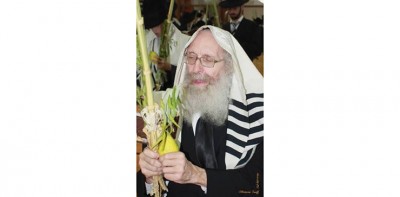
Why does the lulav receive such prominence on Sukkot? Of the Four Species, the etrog represents the tzaddik—a Jew filled with both Torah and good deeds. You’d expect that to be the star of the mitzvah. And yet, the berachah we recite is al netilat lulav, not al netilat etrog. The lulav—along with the hadasim and aravot—is held in the right hand, the place of honor. The etrog, surprisingly, is held in the left.
What message is hidden here?
I heard from my father, Rav Yitzchok Fingerer shlita, a beautiful answer based on the Kesav Sofer. The lulav, hadasim, and aravot each represent different types of Jews—those still growing, those struggling, those disconnected. The etrog represents the perfected Jew. But when that etrog joins the others, something remarkable happens: the presence of the tzaddik awakens the spark in everyone else.
Suddenly, the once-distant Jew wants to grow. He’s moved. Inspired. He starts to change. And that change—teshuvah—elevates him even higher than the etrog. That’s why the berachah is recited on the lulav. That’s why it’s held in the right hand.
As Chazal say, “In the place where baalei teshuvah stand, even the completely righteous cannot stand.” (Berachos 34b)
The Crushed Lulav
This message was deeply embodied by Rav Nosson Tzvi Finkel zt”l, Rosh Yeshiva of Mir Yerushalayim. Before Sukkot, his children would bring him many sets of arba minim so he could choose the most beautiful for the mitzvah.
One year, a bachur had to leave yeshivah between Yom Kippur and Sukkot, leaving his lulav carefully tucked beside his dorm bed. When he returned, he found it completely crushed—rendered pasul. His bedding was disturbed, and it was clear someone had used the bed without asking.
Hurt but quiet, the student confided in Rav Nosson Tzvi. The Rosh Yeshivah responded with warmth: “Many people bring me lulavim. Come to my house and choose one for yourself.”
That afternoon, the bachur arrived and saw a table laid out with beautiful lulavim. He picked one gratefully and offered to pay.
Rav Nosson Tzvi refused full payment. “Pay only what you paid for the first one,” he said. But he added a condition: “You must not bear a grudge against your roommate.”
The boy agreed and left uplifted. Only later did he discover that Rav Nosson Tzvi had no extra lulavim. He had asked every family member to put theirs on the table—then ensured they each had one except for himself.
That lulav—the one that replaced what was crushed—came from sacrifice, from peace, and from love of a fellow Jew.
The Joy of Unity
This is Sukkot. It’s not about perfection—it’s about coming together. It’s about taking every kind of Jew—learned, distant, trying—and holding them in one hand. It’s about lighting the flame of return and realizing that the journey itself is holy.
Sometimes, the most precious lulav isn’t the straightest or the tallest. Sometimes, it’s the one that got crushed—and then lifted up by someone else’s kindness.
Aryeh Fingerer is a passionate Jewish speaker who connects with readers around the world through his meaningful and relatable divrei Torah. He’s dedicated to spreading positivity and strengthening our bond with Yiddishkeit through stories, insights, and timeless Torah values.
Listen to our podcast, Jewish ‘n Joyful, on all streaming platforms! Sign up for our email list or join our WhatsApp group by emailing This email address is being protected from spambots. You need JavaScript enabled to view it. or texting 646-397-2320.
Our weekly newsletter is fi lled with Torah insights, inspiring stories, and uplifting thoughts on the parshah. Check out www. parshaknowledge.com for more info.
Wishing you a wonderful Shabbat and a smile!
Sukkot: Why So Great? It’s Crushed?!
Typography
- Smaller Small Medium Big Bigger
- Default Helvetica Segoe Georgia Times
- Reading Mode




